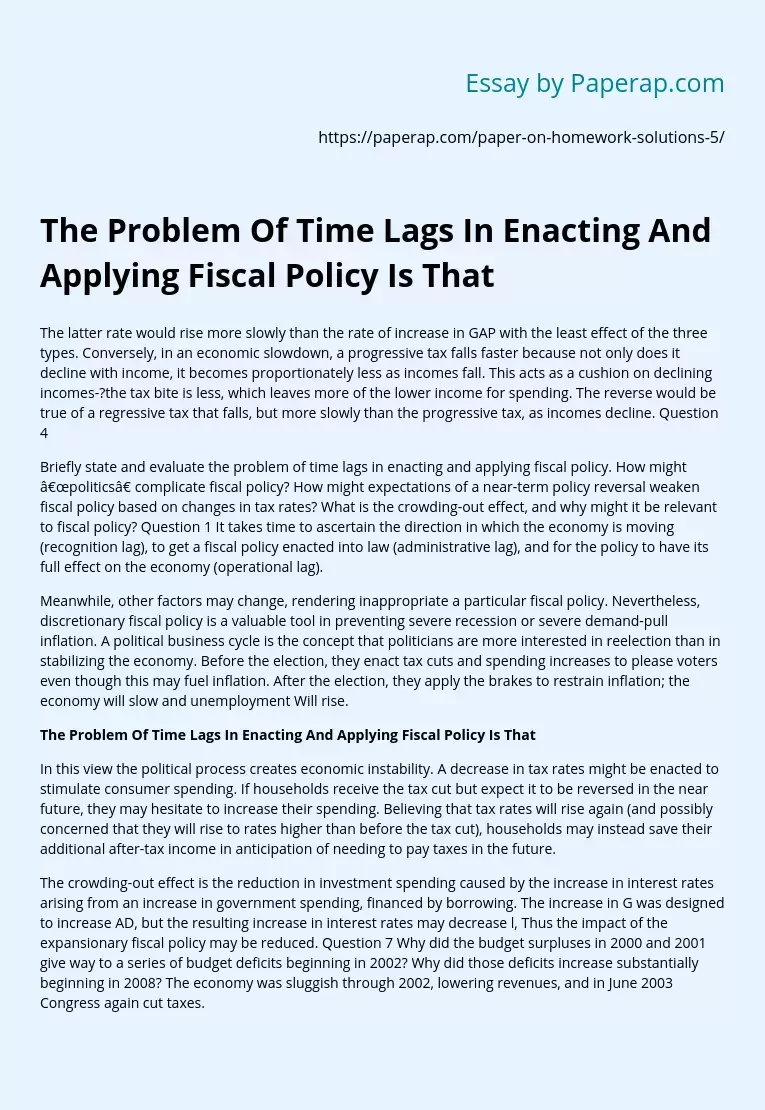The Problem Of Time Lags In Enacting And Applying Fiscal Policy Is That
The latter rate would rise more slowly than the rate of increase in GAP with the least effect of the three types. Conversely, in an economic slowdown, a progressive tax falls faster because not only does it decline with income, it becomes proportionately less as incomes fall. Does this act as a cushion on declining incomes-?the tax bite is less, which leaves more of the lower-income for spending. The reverse would be true of a regressive tax that falls, but more slowly than the progressive tax, as incomes decline.
Question 4
Briefly state and evaluate the problem of time lags in enacting and applying fiscal policy. How might “politics” complicate fiscal policy? How might expectations of a near-term policy reversal weaken fiscal policy based on changes in tax rates? What is the crowding-out effect, and why might it be relevant to fiscal policy? Question 1 It takes time to ascertain the direction in which the economy is moving (recognition lag), to get a fiscal policy enacted into law (administrative lag), and for the policy to have its full effect on the economy (operational lag).
Meanwhile, other factors may change, rendering inappropriate a particular fiscal policy. Nevertheless, discretionary fiscal policy is a valuable tool in preventing severe recession or severe demand-pull inflation. A political business cycle is a concept that politicians are more interested in reelection than in stabilizing the economy. Before the election, they enact tax cuts and spending increases to please voters even though this may fuel inflation. After the election, they apply the brakes to restrain inflation; the economy will slow, and unemployment Will rise.
In this view the political process creates economic instability. A decrease in tax rates might be enacted to stimulate consumer spending. If households receive the tax cut but expect it to be reversed in the near future, they may hesitate to increase their spending. Believing that tax rates will rise again (and possibly concerned that they will rise to rates higher than before the tax cut), households may instead save their additional after-tax income in anticipation of needing to pay taxes in the future.
The crowding-out effect is the reduction in investment spending caused by the increase in interest rates arising from an increase in government spending, financed by borrowing. The increase in G was designed to increase AD, but the resulting increase in interest rates may decrease l, Thus the impact of the expansionary fiscal policy may be reduced. Question 7 Why did the budget surpluses in 2000 and 2001 give way to a series of budget deficits beginning in 2002? Why did those deficits increase substantially beginning in 2008? The economy was sluggish through 2002, lowering revenues, and in June 2003 Congress again cut taxes.
The Problem Of Time Lags In Enacting And Applying Fiscal Policy Is That. (2019, Dec 05). Retrieved from https://paperap.com/paper-on-homework-solutions-5/

